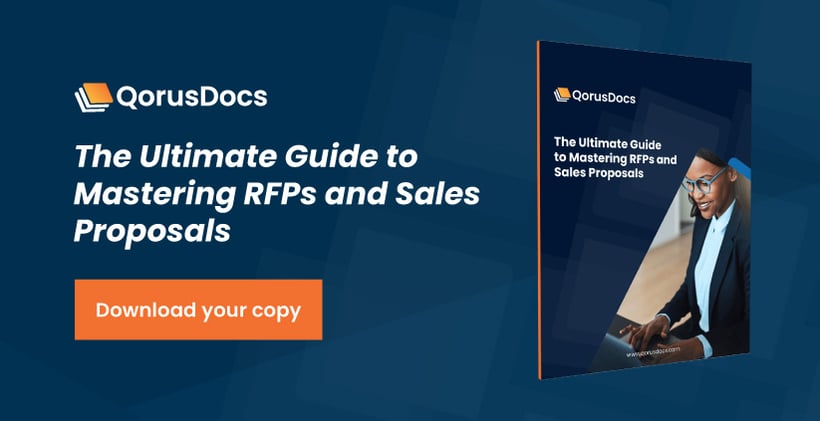The Customer Connection: How QorusDocs Relationship Managers Help Teams Work Smarter and Win More
At QorusDocs, we understand the pressure proposal and bid teams are under to create winning proposals and RFP response documents—and we’re here to help. In addition to bringing you our life-changing (just ask our customers!) proposal management software, we’ve got some tips and tricks up our sleeve to help you craft sales documents that will wow clients and bring home the sale.
Before You Start
Tip #1: Be discerning.
When a sales opportunity presents itself, it’s tempting to just jump straight into writing the proposal or RFx response document. But before you start writing content, designing graphics, or reaching out to SMEs for input, make sure you thoroughly evaluate the opportunity. Not every RFP will make sense for your organization and you need to be sure you can meet all the requirements of the prospective client.
Considerations:
- For an RFP response, do you have a compliance matrix? This step will help you outline the workload and see how the line of questioning from the prospect is playing out.
- Have you confirmed whether your company can meet the requirements outlined? If you have concerns about any of the requirements, be sure to have stakeholder conversations before you get started.
- Can you price the requirements competitively and still be profitable?
- Do you have the right team and timeframe to perform the work?
Tip #2: Don’t skip the background work.
We’ve all heard the adage “Failing to plan is planning to fail” and, in the realm of proposal management, it definitely rings true. In a nutshell: be prepared.

- Collect background info about client and competitors.
- Gather a complete history of work with this client, client reviews, and client pricing.
- Analyze potential competitors and pricing.
- Assign specific questions to team members early so they can complete in a timely manner.
- Have you created a set of proposal planning templates you can reuse every time you have a new proactive proposal or RFP response?
Knee Deep in the Proposal Process
Without a streamlined and efficient proposal process, your team will struggle to respond effectively to all the opportunities coming through your door. Sloppy, incomplete, or unprofessional response documents inevitably fail to impress prospects and you’re right back to square one. Whether you’re a one-man show or are working in a bid and proposal team, getting the proposal workflow humming along like a well-oiled machine is foundational to your success.
Tip #3: Ensure collaboration is easy, quick, and seamless.
Tasks such as working with Subject Matter Experts (SMEs) to build content and collaborating with team members to produce multiple response documents—all within tight deadlines—are part of every proposal professional’s typical workday. But the process can be time-consuming and frustrating if there isn’t a system in place to streamline communication and knowledge exchange.
- Set aside time for collaboration with SMEs, taking their time zones and locations into consideration.
- If you have proposal management software, you can leap ahead in your ability to collaborate and co-author documents at the same time.
- Schedule regular check-ins with co-workers and experts to ensure everyone remains on track.
- Leave sufficient time for review; ensure you’ve addressed every requirement and have proofread content carefully.
|
To create winning documents, the response process should:
|
Creating Docs that Rock
Tip #4: It’s not about you.
A customer-centric approach is crucial for creating RFx responses, proposals, and pitches that resonate with the prospect and influence their decision-making process. Your sales document has a weighty task: it needs to convey your knowledge of the client, their industry, and their unique challenges—plus, clearly illustrate how your solution benefits them!
- Have you identified the prospect’s top challenges and goals and included this information in the opening sections of your proposal?
- Have you addressed how your organization will add value to the prospect’s business and solve their problems?
- Have you translated your features/service offering into tangible benefits that speak directly to the prospect’s needs and how you will help them reach their goals?
Tip #5: Get personal.
Personalization of the response document is an effective engagement and persuasion tool. In fact, according to Salesforce research, 66% of customers expect companies to understand their needs and expectations. By customizing the content to your prospect’s requirements, you’re speaking their language and demonstrating that you understand their business, challenges, and expectations.
- Have you researched what is happening within the customer’s industry and their specific business?
- Did you stick to the structure the prospect provided in their questionnaire/bullet points?
- Have you subtly reflected the prospect’s branding by adopting their color scheme, style, and tone throughout the proposal?
Tip #6: Stand out from the crowd.
Differentiation of your offering is essential to winning new business and growing existing client business. You need to clearly explain how your solution or service stands head and shoulders above the competition.
- Cite references and accomplishments that demonstrate your uniqueness.
- Substantiate claims you’ve made about your organization and what sets it apart.
- Think through your services/skills/partnerships that will benefit the project and possibly save the prospect money.
|
To land the client, response documents should:
|
Tip #7: Style + substance wins business.
When it comes to style, this is not the time to experiment with fonts or other distracting design elements. Professional and polished response documents go a long way to closing a deal.
- Use succinct language; be direct and simple, as though you’re having a business conversation.
-
Break up long or overly verbose sections into small sections with subheadings.
-
Be sure to include the necessary legal language.
-
- Visuals can be helpful when you want to make a lasting impression on prospects.
- Use graphics to illustrate key differentiators, solution benefits, and business concepts.
- Make sure graphics/images you include have a relevant place in the presentation.
- Ensure images are high resolution.
Tip #8: Bring it home.
The last mile of the response process—the presentation and delivery to the client—is your chance to shine.
- Be sure to deliver in the format the client requested (Excel, PDF, etc.)
- Post-proposal meetings: if you’re given the opportunity to meet with the client to review your offering, readily accept.
- Ask questions to get feedback.
- Find out how your firm compares to the competition.
- If given the chance to present, make sure you prepare and review:
- Presentation
- Attendees
- Script speaking topics and order
- Reflect the attire of your clients
- Win or lose, consider asking the client if they’d be willing to discuss what did and did not work about your proposal and presentation.
With these eight insider tips and tricks in your proposal tool kit, you’ll be creating winning proposals, pitches, and RFx response documents at scale in no time!
For more info on how to build a streamlined proposal management process at your organization, you may find our Ultimate Guide to Mastering RFPs and Sales Proposals useful. And if you’re curious how proposal management software can transform your response process and drive more revenue down the pipe, check out 5 Ways Proposal Management Software Fuels Sales. 

May 11, 2023


